Physical therapy at STAR Physical Therapy can be very useful for patients with back pain both before having a facet joint injection as well as afterwards. After having an injection there may be a short window of time where you have some relief from your pain and this window often allows you to more effectively rehabilitate your back and improve your overall movements. This may in turn decrease your symptoms long term.
Generally it is not recommended to treat any pain you have that is directly related to the injection itself for at least a few days. The injection is done specifically to determine how your back reacts to the injected substances, so waiting and watching to see if there is discomfort or relief specifically from the injection is the best approach at first. If, however, you have ongoing pain from the injection itself that lasts longer than would be expected, or your original pain returns after the injection your physical therapist can treat this pain. They may use heat, ice, or electrical modalities such as ultrasound or interferential current to help decrease your pain. They may also massage around your back, buttocks, and hip areas to provide relief by relaxing tight muscles that could be pulling on the joints of the back. In addition, while working to calm your back pain your physical therapist will ask you to limit or modify any activities that irritate your back. A short period of resting from aggravating activities can be very useful along with physical therapy treatment in reducing any acute irritation.
In order to know how best to treat your individual back problem, your physical therapist will assess your back and will determine how well your back is moving. If it is determined that the movement of the facet joints in your back is limited, encouraging more motion can help to ease your pain. Your physical therapist has several methods to help increase the motion in your back. These methods may include using joint mobilizations or manipulations, performing passive stretching, and massaging any tight muscles related to the area. Stretches and strengthening exercises as part of a home program will also be prescribed as they can help you gain more motion in your back, as well as improve the strength and endurance of the muscles that help to support your back. These exercises may be targeted at your low back directly, but will also include exercises for your abdominals and trunk (core) area, buttocks and hips, groin, and the front and back of your thighs.
Maintaining a strong core muscle area is the most crucial part of managing your back pain and allowing you to maintain as active of a lifestyle as you can despite any chronic pain. Your physical therapist can teach you how to properly activate the core muscles and build up their strength and endurance. Even just simple exercises such as gently tightening the muscles of your deep abdominal area directly after you have received your injection will help to support the back. If your therapist has deemed your back to be relatively moving too much, then the core exercises are even more crucial. Stretching exercises that target the tight muscles, which may be pulling the back into an adverse position, will also be prescribed. As you improve your activation, strength, and endurance of your core muscles, more advanced exercises will be prescribed in order to challenge the ability of these muscles and ensure they can stabilize the spine during everyday functional activities.
Another area particularly important in helping to support your back is your hip/buttocks (gluteal) area. Your therapist will assess both the range of motion of your hips as well as the ability of your gluteal muscles to support the hips and back. If your hip range of motion is poor or your gluteals are not strong enough then extra stress is transferred to your low back. Again, often that short window where you may have less pain after your facet joint injection is a time when you can more effectively strengthen your buttocks muscles. The flexibility of the anterior hip muscles as well as the muscles of the front and back of your thigh will also be assessed and stretches may be provided if any of these muscles are found to be tight or overactive.
Doing your prescribed exercises in a hydrotherapy pool may be a useful option for you that you can discuss with your therapist. Often the warmth of the pool and the hydrostatic properties of the water can make range or motion, strengthening, and overall retraining of muscular control easier.
As with any injury or biomechanical dysfunction, maintaining one’s posture and alignment is very important. Despite whether your physical therapist determines that your low back has increased or decreased motion, they will be strict in encouraging you to maintain proper posturing and alignment at all times. Maintaining good posture can significantly decrease the stress put through the back. Any window of time that you have which is pain-free after your injection can also be particularly useful in re-training your body to maintain proper alignment. By improving the endurance of the muscles that support your back, you will be able to maintain your posture and alignment for longer periods of time, and lengthen the time frame between painful flare-ups.
In addition to your posture your gait will also be reviewed. Pain not only affects your static posture but can also cause you to develop an inefficient walking pattern that puts unnecessary stress on joints in the lower extremities and the back. In a normal day most people take thousands of steps just to get around, therefore an inefficient or improper walking pattern can quickly lead to pain either in the back itself or other related joints. Your physical therapist will assess your gait and ensure that you are walking properly.
Your physical therapist may also suggest the use of tape or a back brace in order to help manage your back pain. Tape can be a useful method to assist the muscles to support your back. A brace can help to support your back long-term particularly during prolonged static or active periods. Sometimes a trial of tape before an expensive brace is purchased is a good method of determining the potential use of a brace. Your physical therapist can discuss whether or not they feel a brace would be useful in your individual case.
Once your back pain is under control your therapist will discuss the importance of a cardiovascular program to assist in managing your back pain long-term. At STAR Physical Therapy we believe that maintaining your overall fitness level is an effective method in helping to manage both the pain and stress that comes with chronic pain and is a way to help decrease the number of flare-ups of your injury that occur. Your therapist can discuss with you the best cardiovascular activity options that would be appropriate in your individual case. Often cycling, water aerobics or water running, or other low impact activities are the most appropriate ones to try particularly after a facet joint injection.
Generally the treatment we provide at STAR Physical Therapy for your back after a facet joint injection can assist greatly in managing your back pain but it should be remembered that these injections are not generally a cure for your chronic pain; they are only a part of your overall pain management plan. You will need to continue working long- term with your doctor, physical therapist, and any other health care professional involved in your pain management. You will also need to continue faithfully doing your rehabilitation home program in order to best manage your back pain. If your pain is ongoing despite the injection and regular physical therapy treatment your doctor may want to discuss with you the possibility of another injection or other more aggressive pain management options.
Portions of this document copyright MMG, LLC.
STAR Physical Therapy provides services for physical therapy in Fairport and Rochester.
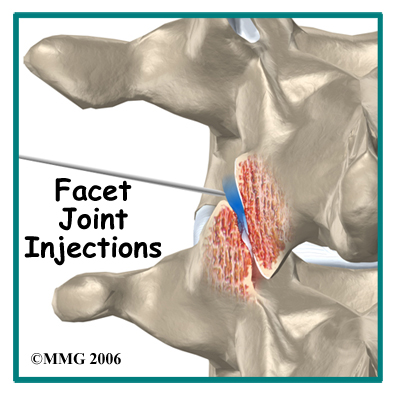 When dealing with a chronic painful spine condition pain specialists commonly use facet joint injections. These injections are primarily diagnostic injections, meaning that they help your doctor determine the cause of your back pain but they can also help to treat the painful condition, although they may not provide you with any long-term relief. Facet joint injections eliminate pain temporarily by filling the facet joint with an anesthetic medication that numbs the joint, the ligaments, and the joint capsule around the facet joint. If the facet joint is injected and your pain goes away for several hours, then it indicates to your doctor that it is very likely the joint or its closely related tissues that are causing your pain. Once you and your doctor know what structure is causing your pain, you can begin to explore options for treating the condition.
When dealing with a chronic painful spine condition pain specialists commonly use facet joint injections. These injections are primarily diagnostic injections, meaning that they help your doctor determine the cause of your back pain but they can also help to treat the painful condition, although they may not provide you with any long-term relief. Facet joint injections eliminate pain temporarily by filling the facet joint with an anesthetic medication that numbs the joint, the ligaments, and the joint capsule around the facet joint. If the facet joint is injected and your pain goes away for several hours, then it indicates to your doctor that it is very likely the joint or its closely related tissues that are causing your pain. Once you and your doctor know what structure is causing your pain, you can begin to explore options for treating the condition.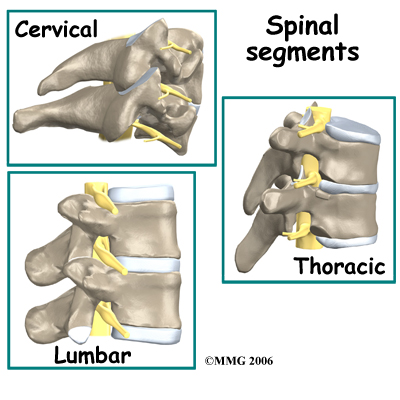 The surfaces of the facet joints are covered by articular cartilage. Articular cartilage is a smooth, rubbery material that covers the surface of all synovial joints. It allows the bone ends to move against each other smoothly without friction.
The surfaces of the facet joints are covered by articular cartilage. Articular cartilage is a smooth, rubbery material that covers the surface of all synovial joints. It allows the bone ends to move against each other smoothly without friction.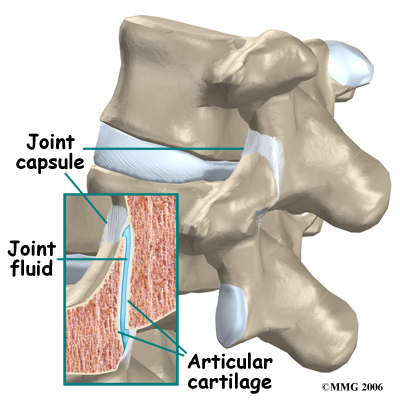
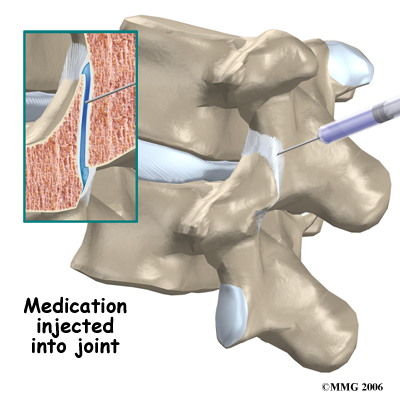 Your doctor is recommending a facet joint injection to try and determine if the joints are the cause of your back pain. As mentioned above, this type of injection is primarily a diagnostic injection. The injection may only reduce your pain temporarily; possibly only for a few hours. Once your doctor is sure that it is the facet joint causing your pain, other procedures may be recommended to reduce your pain for a longer period of time.
Your doctor is recommending a facet joint injection to try and determine if the joints are the cause of your back pain. As mentioned above, this type of injection is primarily a diagnostic injection. The injection may only reduce your pain temporarily; possibly only for a few hours. Once your doctor is sure that it is the facet joint causing your pain, other procedures may be recommended to reduce your pain for a longer period of time.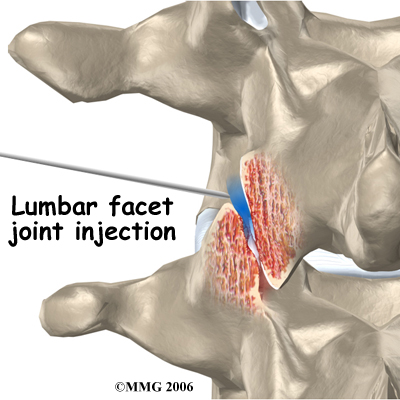
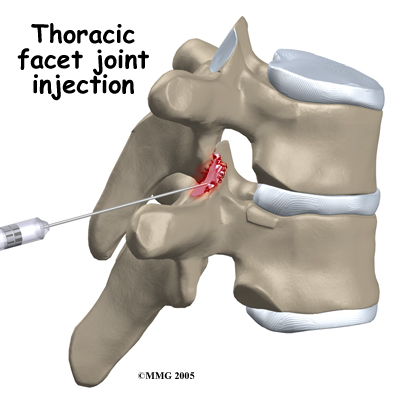 Cortisone is an extremely powerful anti-inflammatory medication. When this medication is injected into a painful, inflamed joint, it can reduce the inflammation and swelling. Reducing the inflammation reduces pain. If cortisone is also injected into the joint at the same time, you may get several weeks of relief from your pain. This period of pain relief can allow you to get started in or continue on with a physical therapy program, strengthen the muscles, and begin to move normally again. In some cases when the cortisone wears off, the pain may not return.
Cortisone is an extremely powerful anti-inflammatory medication. When this medication is injected into a painful, inflamed joint, it can reduce the inflammation and swelling. Reducing the inflammation reduces pain. If cortisone is also injected into the joint at the same time, you may get several weeks of relief from your pain. This period of pain relief can allow you to get started in or continue on with a physical therapy program, strengthen the muscles, and begin to move normally again. In some cases when the cortisone wears off, the pain may not return.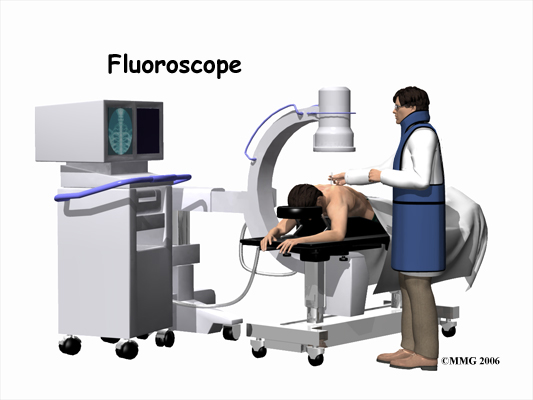 Most injection procedures today are done with the help of fluoroscopic guidance. The fluoroscope is an x-ray machine that allows the doctor to actually see an x-ray image while doing the procedure. This allows the doctor to watch where the needle goes as it is inserted and makes the injection much safer and more accurate.
Most injection procedures today are done with the help of fluoroscopic guidance. The fluoroscope is an x-ray machine that allows the doctor to actually see an x-ray image while doing the procedure. This allows the doctor to watch where the needle goes as it is inserted and makes the injection much safer and more accurate.